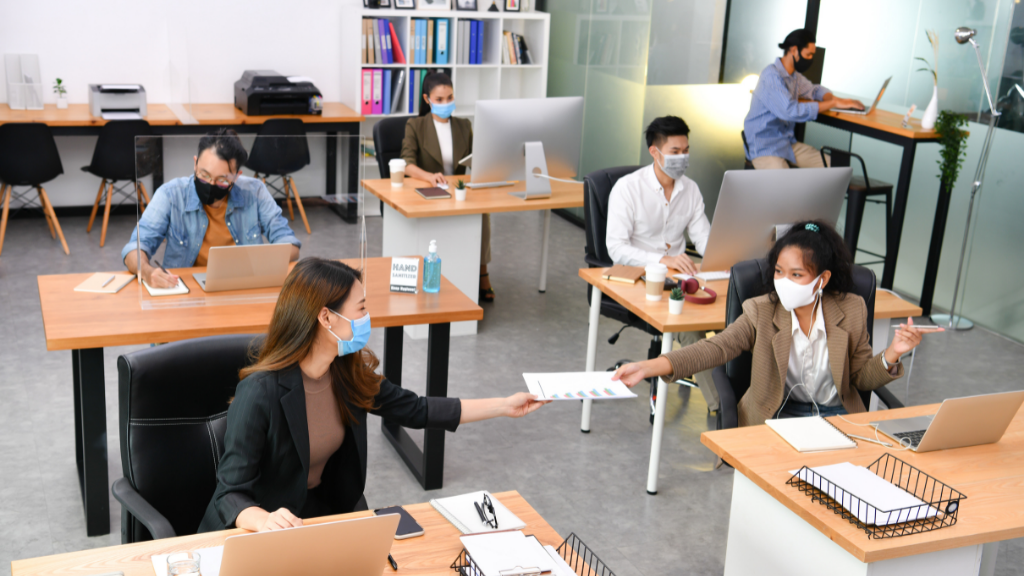In April this year, Singapore allowed its people to re-enter the workplace. At that time, up to 75% of employees can enter the workplace at any one time. However, due to a spike in COVID-19 cases, work-from-home (WFH) is now the default for employees who can work from home.
The majority of the companies in Singapore are expecting a more hybrid approach. But employees that are required to enter the workplace are strongly encouraged to self-test weekly via an Antigen Rapid Test (ART). This is because the workplace remains to be one of the common places where the COVID-19 virus and the highly transmissible Delta variant can be transmitted.
To ensure that the general workplace setting remains safe for all employees, the tripartite partners, the Ministry of Manpower (MOM), Singapore National Employers Federation (SNEF), and National Trades Union Congress (NTUC) have updated the workplace Safe Management Measures.
Safe Management Measures*

1) Taking care of your workers
To slow the rate of transmission, WFH remains the default. Employees that can afford to work from home are required to do so while employees that are required to be onsite are encouraged to self-test weekly using the Antigen Rapid Test (ART).
Starting on 1 January 2022, unvaccinated employees are not allowed to return to the workplace unless they have a negative ART test result administered by a Pre-Event Test (PET) at an MOH-approved COVID-19 test provider 24 hours before the expected end of work.
2) For employees, contractors, and vendors who are physically onsite at the workplace
Other than being encouraged to self-test, physically onsite employees should wear masks all the time unless they are required to remove them. They should also have their meal breaks separately to avoid any social gatherings.
To spread out employees across time and space, companies should offer flexible working hours and avoid cross-deployments across worksites. If in some cases employees are required to be in more than one worksite, additional safety measures must be taken to minimise the risk of cross-infection.
If there are any work events, the number of persons in an event must not exceed 50 persons and everyone should stay at least one metre away from one another. Food should also be served individually and participants should minimise their time unmasked.
To ensure that all employees are coping well with the current situation, employers should support their employees’ mental well-being, be it in the workplace or WFH. Employers can also consider hybrid work arrangements by implementing Flexible Work Arrangements (FWA) to boost work productivity while ensuring employees’ safety.
3) Taking care of the workplace
When re-entering the workplace, employees should record their entrances and exits via SafeEntry or TraceTogether. This is to help the Ministry of Health (MOH) easily establish potential transmission chains.
Employers should also reduce the need for common physical touchpoints by implementing safe distancing measures and contactless access controls. Common spaces such as the meeting rooms, pantries, and lifts must be well-ventilated, cleaned and sanitised regularly per the National Environment Agency’s (NEA) advisory.

4) If an employee is infected
Employees should inform their employers if they are feeling unwell, tested positive for COVID-19, or are identified by MOH as close contact of someone with COVID-19. Here are the simplified Health Protocols:
- Protocol 1 – If you are unwell, you must visit a Swab And Send Home clinic using private transport. A doctor will assess your condition and advise you on your next steps.
- Protocol 2 – If you are feeling well but are tested positive, you must isolate yourself at home for 72 hours and repeat the ART after. You can only end your isolation once your ART result appears to be negative.
- Protocol 3 – If you are identified by MOH as a close contact of someone with COVID-19, you must take an ART on the first day you were identified as close contact and upload your result at go.gov.sg/agsubmit. After seven days of monitoring, you can proceed to end your isolation when your ART self-test result appears negative.
As for employers, upon notification that their employee/s had been infected, they are encouraged to establish if the employee had interacted closely with anyone else, conduct ART on close contacts, follow the protocol if there are other infected employees, and disinfect the areas used by infected employees. Employers must understand the risk of transmission at the workplace and adhere to the Safe Management Measures.
5) Implementing the Safe Management Measures system
To ensure that the Safe Management Measures are implemented correctly, employers must establish a system to implement it sustainably. This can be done by creating a detailed monitoring system to ensure compliance with the Safe Management Measures, communicating system to employees to avoid misunderstandings, and putting up signs to remind employees to adhere to the system and measures in place.
Employers can also appoint a Safe Management Officer(s) (SMO) who will be in charge of implementing, coordinating and monitoring the system at the workplace. SMOs can also keep records of inspections and rectify any non-compliance found during inspections.
All in all, working from home remains to be the default. But for reasons that employees are required to enter the workplace, Safe Management Measures must be properly implemented and monitored to ensure employee safety. For more information, send in your immigration-related questions with us.
*Safe Management Measures are accurate as per time of posting.



